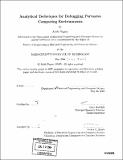Analytical techniques for debugging pervasive computing environments
Author(s)
Nigam, Atish, 1981-
DownloadFull printable version (4.755Mb)
Other Contributors
Massachusetts Institute of Technology. Dept. of Electrical Engineering and Computer Science.
Advisor
Larry Rudolph.
Terms of use
Metadata
Show full item recordAbstract
User level debugging of pervasive environments is important as it provides the ability to observe changes that occur in a pervasive environment and fix problems that result from these changes, especially since pervasive environments may from time to time exhibit unexpected behavior. Simple keepalive messages can not always uncover the source of this behavior because systems can be in an incorrect state while continuing to output information or respond to basic queries. The traditional approach to debugging distributed systems is to instrument the entire environment. This does not work when the environments are cobbled together from systems built around different operating systems, programming languages or platforms. With systems from such disparate backgrounds, it is hard to create a stable pervasive environment. We propose to solve this problem by requiring each system and component to provide a health metric that gives an indication of its current status. Our work has shown that, when monitored at a reasonable rate, simple and cheap metrics can reveal the cause of many problems within pervasive environments. The two metrics that will be focused on in this thesis are transmission rate and transmission data analysis. Algorithms for implementing these metrics, within the stated assumptions of pervasive environments, will be explored along with an analysis of these implementations and the results they provided. Furthermore, a system design will be described in which the tools used to analyze the metrics compose an out of bound monitoring system that retains a level of autonomy from the pervasive environment. The described system provides many advantages and additionally operates under the given assumptions regarding the resources available (cont.) within a pervasive environment.
Description
Thesis (M. Eng.)--Massachusetts Institute of Technology, Dept. of Electrical Engineering and Computer Science, 2004. Includes bibliographical references (p. 63-65).
Date issued
2004Department
Massachusetts Institute of Technology. Department of Electrical Engineering and Computer SciencePublisher
Massachusetts Institute of Technology
Keywords
Electrical Engineering and Computer Science.